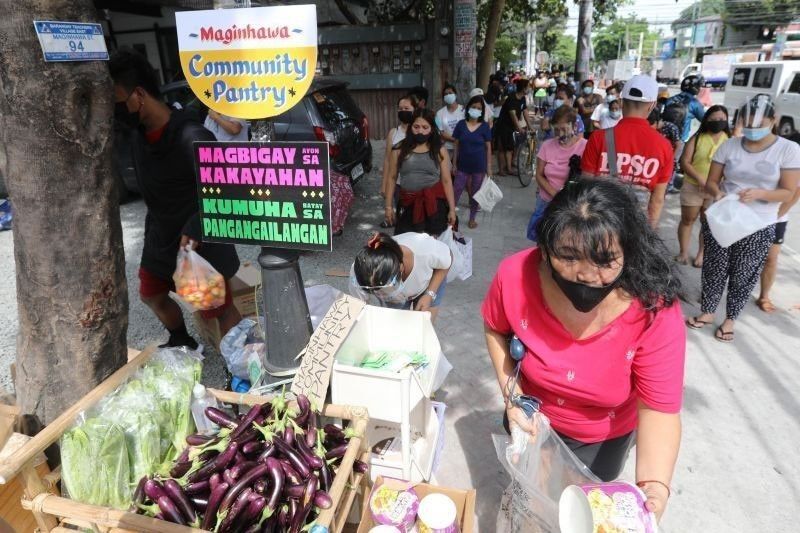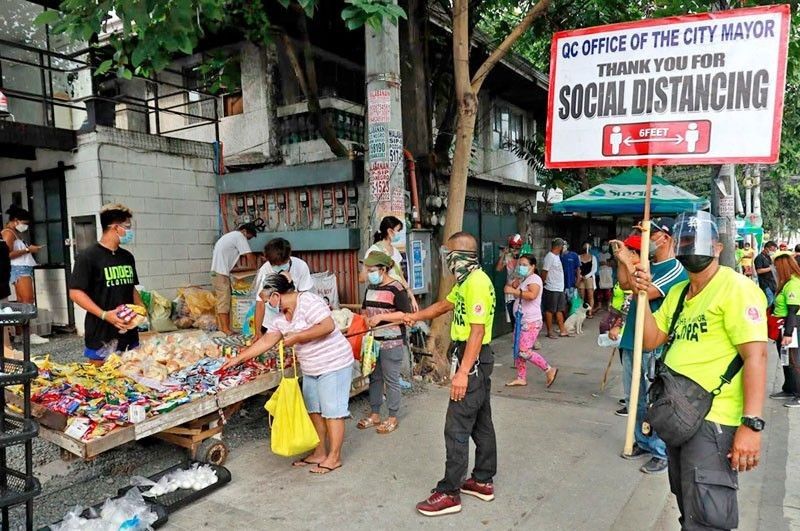A month after, pantries thrive or die as help movement evolves

MANILA, Philippines — On April 21, Idelle Kristiana Ison, who took a break from college this year, invited her older sisters to join an unfolding bandwagon: put up a community pantry, gather donations and help the needy.
The virality of these pantries hit the Philippines like a tidal wave, riding on the impetus of traditional alms giving. The pandemic environment was ripe for such a movement: in Metro Manila alone, over a quarter of residents are hungry, a tenth are jobless despite the economy reopening, and government has wasted time debating whether to give out larger stimulus checks or protect its balance sheet from new spending.
The likes of Ison, 24, believe help can no longer wait. Hence, they joined hundreds in opening a pantry last month, seeing donations poured in the first, second and third days. Around a hundred people lined up to get a bag of rice, some eggs and vegetables each day. And then a week passed, and by that time she and her siblings realized, they are running out of stock. “We were open every day. After the seventh day, we decided to make it every other day,” Ison said in a phone interview.
“To be honest, right now, it feels like we’re merely surviving,” she said.
Over a month since makeshift markets suddenly sprouted in the country, a few like Ison’s are finding themselves on the brink of closing shop, unable to survive merely on the back of an overwhelming sense of generosity. Not that they are supposed to earn in the first place, but pantries, like any venture, require more than dedication to survive. It requires capital, and in this case, that means counting on a constant flow of donations. That is until they eventually dry up.
This so-called “donor fatigue” is already setting in. In many Facebook groups, community pantries have sounded appeal to fill up their shelves so that they can continue serving. The most vulnerable are the small ones set up at their own residences at the height of the news cycle and are now struggling. In these rather heartbreaking instances, pantry owners were more than willing to help, if only the resources are sufficient.

But for humanitarian experts, a pantry’s success should be measured based solely on its intent, and not for how long it runs. “I would suggest keeping the bar low when it comes to evaluating success of the pantries. Feeding but a few hungry people is already a successful response,” Manja Vidic, head of the UN Office for Humanitarian Affairs in the Philippines, said in an email.
Indeed, pantries themselves are not a novel idea as band-aid solutions during a crisis. In the past, food banks were set up near areas devastated by natural disasters such as in the aftermath of Typhoon Yolanda in 2013 when the Rotary Club opened a soup kitchen in Ormoc City. Similarly, at the onset of the pandemic in April 2020, the Catholic Church through NASSA/Caritas Philippines opened “kindness stations” which have a similar concept to that of pantries. All these efforts have come and go just as the need for them slowly dissipated, or resources dwindled.
On the ground growth
The same can be said for pantries. But as the pandemic’s effects proved to be more lasting and scarring, these help outlets are also not taking the challenge sitting down. For one, those same Facebook groups have served as a venue for smaller pantries to band together. The biggest evidence of this is that one led by Ana Patricia Non, credited for starting the pantry movement, who is now leading the coordination of 650 pantries in Metro Manila, Bulacan, Laguna, Cavite and Rizal.
Goods are delivered to pantries through distribution hubs established in these areas. They come from three “central pickup points” in Matiyaga, Matatag and Maginhawa streets in Quezon City— the latter pantry evolving from being the trailblazer of all pantries. On Tuesdays and Fridays, eight tons of vegetables would arrive in these hubs from the northern provinces of Benguet and Ifugao.
Apart from veggies, rice supplies are also consistently flowing from farmers bought by pantries directly from them using donated funds. This has benefited farmers who do not have to shoulder hefty costs associated with hiring middlemen to sell their crops. And in direct contrast with the red-tagging from the state’s indigenous people’s task force, pantries are in fact assisted by trucks hired for delivery by the agriculture department. “We cannot do this alone,” Elijah San Fernando of Matiyaga pantry said.
As some pantries expand, their needs also change. Apart from goods, services from professionals like accountants are now also availed to audit donations. In exchange, these people are given free food while on duty. Soon, Non said the pantry would be releasing financial reports, an answer to calls for transparency from critics. Plans are also underway to build pantries to tribes, especially those displaced from their ancestral homes by land reclamation.
“The goal really is to have a distribution hub in the whole country…But I also recognize that not all pantries will exist indefinitely. But I’m sure as long as people are hungry, there will be at least one pantry out there,” Non said.
From sudden to systematic
A massive growth may not be applicable for all pantries, but in more ways than one, pantries are getting more self-regulated as they continue to operate. Together with community support, this has blocked efforts by government to put them under control.
Such self-regulation need not be big in nature, and can be as simple as enforcing health protocols in crowds, managing operation hours, or even crafting better ways to distribute goods like giving out claim stubs. Reaching out to donors including large companies would also help sustain a pantry. This was what Vonn Vincent Tanchuan and five newly found friends did when their pantry located in Kalayaan Avenue in Makati started serving about 500 beneficiaries each day.
The pantry, put up on April 19, was initially endeavored only to run until May. Donations have started to slow, when they decided to reach out to the corporate social responsibility arm of one of the biggest local banks. That bank has then agreed to provide food supplies every weekend for a month.
“We really didn’t expect to sustain it,” Tanchuan said. “Right now, I cannot tell you for how long we can operate but what we see is even if say, we stop for a while, definitely we’ll open it again when the need arises.”
What's a no-no for pantries however is extensive government intervention. Politics should also be kept out of the pantries, something vital to keep in mind especially if pantries are to continue operating by the next year when elections are held. Lot Felizco, country director at Oxfam Pilipinas, a non-profit charitable organization, said the only area where the government should step in would be to make pantries’ existence no longer a matter of life and death.
“The bigger role of government should be in ensuring adequate social protection for the poorest strata of our population, those who are most severely affected by the pandemic, in such a way that community pantries should actually not become their main lifeline,” Felizco said.
- Latest
- Trending


























 Exclusive
Exclusive